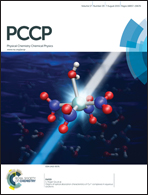Evidence for quantum effects in the predissociation of methylamine isotopologues†
Abstract
Non-adiabatic dynamics at conical intersections (CIs) extensively affects the photostability of biomolecules by efficiently photoinducing decay routes that dissipate harmful excess ultraviolet energy. Here the predissociation of the model test molecules, methylamine (CH3NH2) and its partially deuterated isotopologue (CD3NH2), excited to different specific vibrational modes in the electronically excited state has been experimentally investigated. The H(D) photofragments were detected by two-color reduced-Doppler ion imaging, which allows measurement of their entire velocity distributions in each laser pulse. The fast and slow H products, resulting from N–H bond cleavage, obtained via different dissociation pathways, showed anomalous distributions for some vibronic states, as indicated by dynamic resonances in the product branching ratio and in the anisotropy parameters of the fast H photofragments. This vibronic-specific control is attributed to the sensitivity of the non-adiabatic dynamics to the energy difference between the initially prepared vibrational states and the energy of the CIs and not only to the distinctive pre-excited nuclear motions. The observations in the two isotopologues reveal uniquely detailed insight into the dynamics of state-specific control.


 Please wait while we load your content...
Please wait while we load your content...